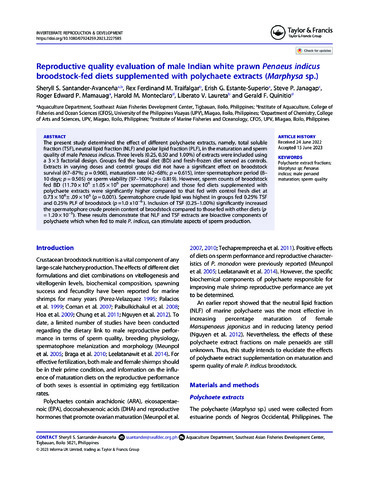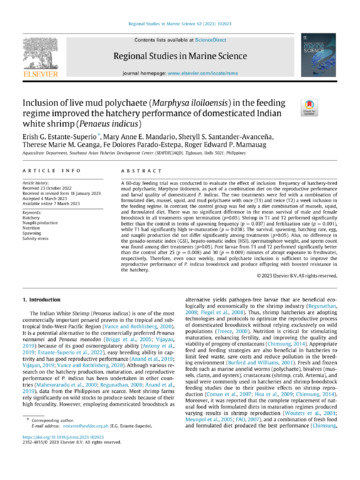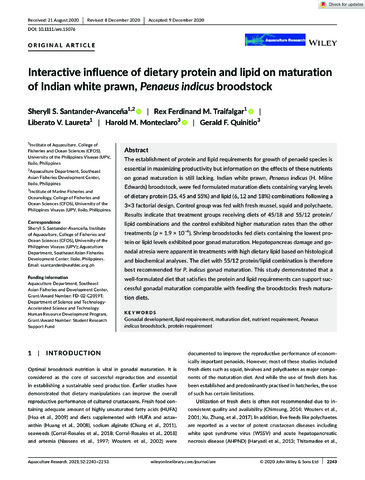| dc.contributor.author | Santander-Avancena, Sheryll | |
| dc.contributor.author | Traifalgar, Rex Ferdinand | |
| dc.contributor.author | Monteclaro, Harold | |
| dc.contributor.author | Castellano, Jose Louis A. | |
| dc.contributor.author | Cordero, Christian | |
| dc.contributor.author | Laureta, Liberato V. | |
| dc.contributor.author | Quinitio, Gerald | |
| dc.date.accessioned | 2022-07-19T05:35:28Z | |
| dc.date.available | 2022-07-19T05:35:28Z | |
| dc.date.issued | 2022-07-15 | |
| dc.identifier.citation | Santander-Avanceña, S. S., Traifalgar, R. F. M., Monteclaro, H. M., Castellano, J. L. A., Cordero, C. P., Laureta, L. V., & Quinitio, G. F. (2022). Evaluation of maturation promoting factor in polychaete (Marphysa sp.) on Indian White Prawn, Penaeus indicus female broodstock. Aquaculture Research, 53(15), 5195–5204. https://doi.org/10.1111/are.16003 | en |
| dc.identifier.issn | 1355-557X | |
| dc.identifier.uri | http://hdl.handle.net/10862/6345 | |
| dc.description.abstract | Polychaete is considered the best maturation diet for penaeids; however, fluctuating supply and quality warrant detailed studies to understand the specific maturation-promoting factors present in polychaete. Indian white prawn, Penaeus indicus, was fed diets supplemented with different fractions of Marphysa sp. extracts. Fractions, such as the total soluble fraction (TSF), neutral lipid fraction (NLF), and polar lipid fraction (PLF), were incorporated in the maturation diet at 0.25, 0.50, and 1.00% following a 3 × 3 factorial design. One group was fed with basal diet (BD), and another was fed with fresh squid, mussel, and polychaete, serving as the control. After a 30-day feeding trial, results showed that the inclusion of polychaete extracts in the diet significantly improved P. indicus maturation compared to groups fed BD and control with 40% maturation rates (MR) (p = 3.4 × 10−4). MR was optimum in groups receiving diets supplemented with ≥0.5% TSF (70.00% ± 0.00) and NLF (60.00% ± 5.77). Similar improved MR was achieved in treatments receiving ≥0.25% PLF supplementation (60% ± 0.00). Accordingly, relative expression of ovarian vitellogenin mRNA of broodstock fed under 0.25 and 0.50% PLF group was 4.44 and 3.96 folds higher than BD, respectively (p = 0.003). No significant differences were detected in the broodstock survival, latency period, hepatosomatic, and gonadosomatic indices. Biochemical content analyses showed no significant differences among the nine treatments except for broodstock's higher ovary protein content in the TSF group (p = 0.037). This study highlights PLF as the most potent component of the polychaete extract in promoting gonad maturation in P. indicus maturation supplemented at a 0.25% optimum inclusion level. | en |
| dc.description.sponsorship | Department of Science and Technology-Accelerated Science and Technology Human Resource Development Program, Student Research Support Fund; Southeast Asian Fisheries Development Center/Aquaculture Department, Grant/Award Number: FD-02-C2019T | en |
| dc.language.iso | en | en |
| dc.publisher | Wiley | en |
| dc.subject | Penaeus indicus | en |
| dc.subject | maturation | en |
| dc.subject | vitellogenins | en |
| dc.title | Evaluation of maturation promoting factor in polychaete (Marphysa sp.) on Indian white prawn, Penaeus indicus female broodstock | en |
| dc.type | Article | en |
| dc.citation.volume | 53 | |
| dc.citation.issue | 15 | |
| dc.citation.spage | 5195 | |
| dc.citation.epage | 5204 | |
| dc.citation.journalTitle | Aquaculture Research | en |
| dc.subject.asfa | diet | en |
| dc.identifier.essn | 1365-2109 | |
| dc.identifier.doi | 10.1111/are.16003 | |
| dc.subject.scientificName | Marphysa | en |
| dc.subject.scientificName | Penaeus indicus | en |
| local.subject | female maturation | en |
| local.subject | Marphysa sp. | en |
| local.subject | Penaeus indicus | en |
| local.subject | polychaete extracts | en |
| local.subject | vitellogenin mRNA expression | en |
| local.subject | Polychaete | en |



